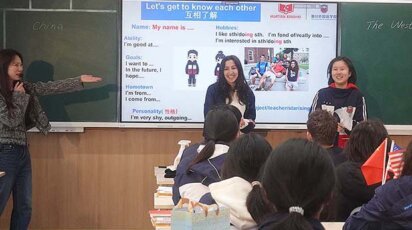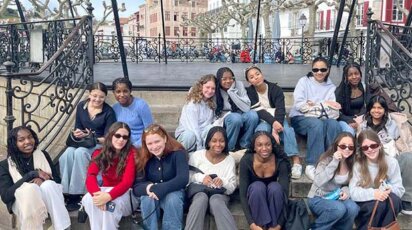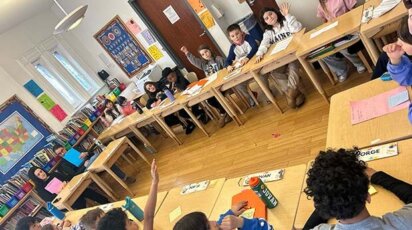News
Teacher Kent Leeklymenko and his class welcomed a visitor to their Introduction to Japanese class saying, “Konnichiwa,” (Hello!) and bowing heads as a sign of respect. This fall is the first time that Japanese is being taught at Poly.
In this beginner’s introduction to the Japanese language, which is open to Grade 12, students learn the rudiments of Japanese reading, writing, listening, and speaking, while also exploring many aspects of Japanese history, culture, linguistics, and popular culture.
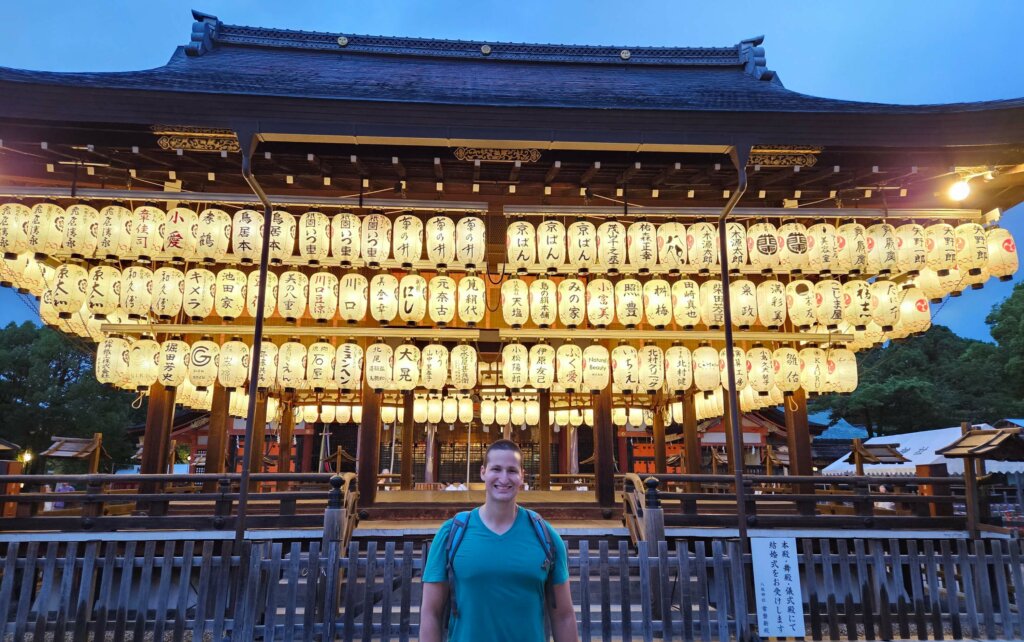
“We are thrilled to continue to expand our elective language offerings in the Upper School for seniors,” said World Languages Department Chair Liz Mansfield. “This new Japanese elective exposes students to a new part of the world and a new way of character reading and writing. How excited we are to have Mr. Leeklymenko teaching our students about the many wonders of Japan!”
In preparation for the class, this past summer, Leeklymenko spent two weeks traveling in Japan, which included Kyoto, Nara, Osaka, Hida Mountains, Kamakura, and Tokyo, to improve his Japanese language skills and learn more about Japanese culture and history.
Leeklymenko has been interested in the Japanese language and culture since he was about 13 years old. “There is still so much that I do not know,” he said, “and there is always so much more to learn. One of the great joys of learning a language is that it is a lifelong journey. It is a process of constant discovery and refinement. I study and learn new Japanese every day. At Poly, I also teach Latin, Ancient Greek, and the senior Philosophy seminar, so it is a wonderful additional experience as an educator to take on the new challenge of an Intro to Japanese class.”
Why is it important for Poly to offer this new class?
“Japanese is a language with immense influence on a global scale,” Leeklymenko said. “Japan is also the third largest economy in the world. Many people outside Japan encounter Japanese words, companies, food, media, games, fashion, literature, philosophy, and many other aspects of the culture regularly. By taking this class, students will begin to gain direct access to and understanding of all these important domains. As well, native Japanese vocabulary and Japanese grammar are completely unrelated to any other language offered at Poly. This class gives students another opportunity to acquire entirely new ways of thinking. At the same time, students will learn many loan words in Japanese, such as Sino-Japanese vocabulary, which form fascinating historical linguistic connections with our other language classes.”
In the Classroom
Approximately 13 students sat around seminar tables listening carefully as Leeklymenko enunciated Konnichiwa and talked about the different pronunciations of the hiragana character “ha,” which is pronounced as “wa” when used as a topic particle. He began to point at words and characters projected on the Promethean smart board. Leeklymenko explained that the Japanese language has a special mark, which sometimes represents “voiced consonants.” This is produced by “vibrations from the larynx.” A student in the front of the class felt her own throat as she pronounced the “ka” syllable changing to the voiced “ga” sound.
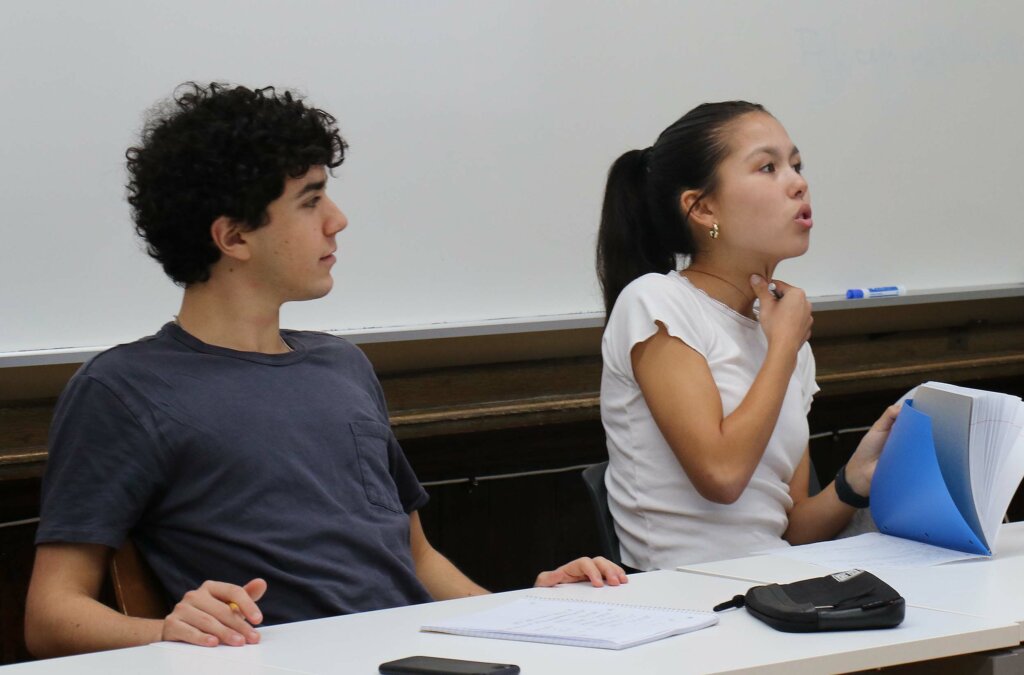
Leeklymenko also pointed out that Japanese characters—kanji, hiragana, and katakana—are derived from Chinese characters.
Link Between Languages
About the relationship between Japanese and the Chinese language, Selena Wu ’25 said, “I never expected that hiragana would draw so heavily from characters as well and from Cantonese pronunciations. I thought it was only kanji that was influenced by Chinese characters. There is also a lot in the way the phrases are constructed that is deeply tied to culture. For example, many phrases begin with ‘o’ indicating that it is something honorable. You can find it in the phrase for good morning and for chopsticks and many other things that show how culturally important or deeply tied into history they are.”
Cultural Nuances Within Language
Leeklymenko explained that an “honorific prefix” shows humility. He began to also discuss phonology and how some words in Japanese begin with sounds such as “ts-” or “ry-” that we do not find at the beginning of native English words, he said. As students answered questions correctly, Leeklymenko smiled and pointed out that this is the “joy of learning another language,” and developing “new ways of thinking.”
He explained that “good night” in Japanese—oyasumi—literally means a wish for “an honorable rest.” He added that “dame” means useless or no good and can be used as one way to express obligation or necessity when used as “if I don’t do this… dame desu (it’s no good)” to mean “I must do this.”
Students Gain Insights
Student Abraham Herzog ’24 says, “I was curious to learn Japanese because I wanted to try a new language for my senior year. I have had no prior experience with the language.”
“What has surprised me the most is how much influence from different cultures can be seen within Japanese,” Herzog continued. “There are many loan words borrowed and adapted for Japanese.”
Jasmine Donald ’24 has been interested in Japanese culture and the language since she was a child. “I was supposed to go to Japan to attend a language school back in 2020,” she said, “but then COVID hit, so once I saw that this Japanese class was being offered, I was so excited.”
“As Mr. Leeklymenko told us on the first day of class,” Donald continued, “Japanese is the hardest language to learn as a native English speaker because of how different it is from English. It was surprising to see just how different it is from English, all the way down to sentence structure.”
For Levi Stein ’24, who was born in Japan where his mother worked, but whose family returned to NYC when he was one, the class has been a reconnection. “Believing we would return to Japan in a few years, my parents hired a Japanese sitter to try to raise me bilingual. We did not end up moving back to Japan, but my sitter stayed with us for 13 years and spoke mostly Japanese to me. Though I would respond in English, I could understand her Japanese conversationally. When I saw Japanese as a new senior language elective, I was eager to join the class and hopefully reconnect with the language.”
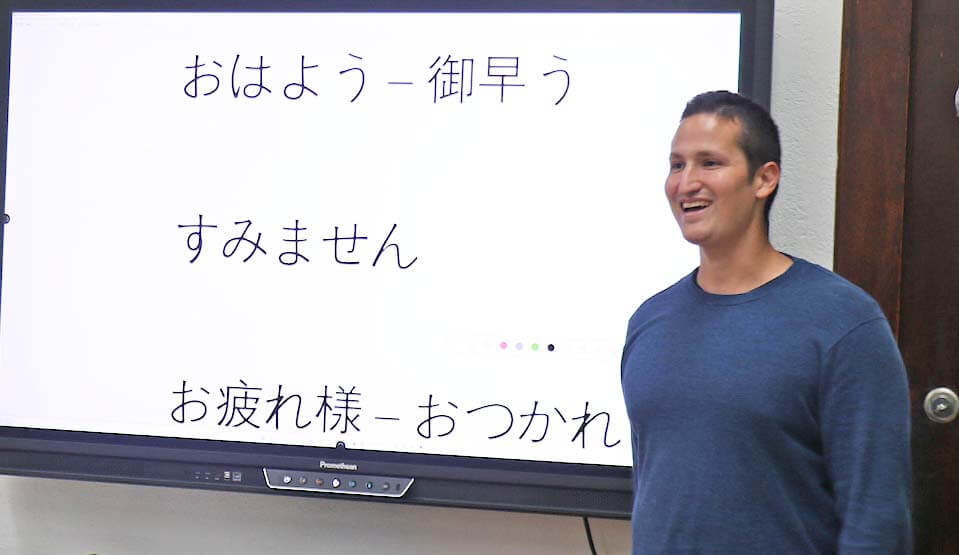
Alex Xiao ’24 “grew up immersed in Japanese culture and media.” He says he was surrounded by Japanese music, art, video games, anime, and friends who shared his interests. “However, I hadn’t considered formally studying the language until the new course was announced in the spring of my junior year. I saw it as an opportunity to engage even further with the culture that I have cherished so much.”
“One of the most surprising traits of the Japanese language that I’ve encountered thus far is its complexity,” Xiao said. “There are three major writing systems—hiragana, katakana, and kanji, all of which are used together in common writing. It’s a little bit daunting. Japanese is often regarded as the most difficult language to learn for native English speakers, but I feel that makes it all the more fulfilling to learn.”
“Mr. Leeklymenko has made learning Japanese fun and interesting,” Herzog added. “My classmates and I look forward to his class every day. He mixes in the learning of new vocab with funny and interesting anecdotes.”
“Leeklymenko sensei has done a great job at pacing the class for everyone,” added Wu, “and keeps the class entertaining and engaging. The energy in the class is great and I find the class very fun!”
“Mr. Leeklymenko is a very entertaining instructor.” He’s made learning this difficult language very fun and exciting. He celebrates us when we are able to read the words on our own and he encourages us when we struggle a bit.”
Jasmine Donald ’24
Xiao said, “Mr. Leeklymenko is a very engaging teacher who provides relatable examples and etymologies for the material we learn. We aren’t just learning how to write Japanese characters; we’re learning about their roots in Chinese written and spoken language, as well as practicing how they’re frequently used in daily activities.”
“I was uncertain if there would be enough student demand for a class,” Leeklymenko said, “so I was very happy to discover that so many students were interested! My students are very enthusiastic about Japanese language and culture. I will work hard to deepen our collective understanding.”

